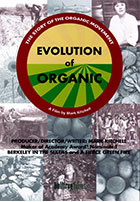
Evolution of Organic: The Story of the Organic Movements 2017
Distributed by Bullfrog Films, PO Box 149, Oley, PA 19547; 800-543-FROG (3764)
Produced by Mark Kitchell
Directed by Mark Kitchell
DVD, color, 86 min.
General Adult
Environmentalism, Organic Food, Political Science, Capitalism
Date Entered: 06/04/2018
Reviewed by Andrew Jenks, California State University, Long BeachRenegades and rebels ultimately have to decide if they will work within the system they criticize or reject it completely in favor of some revolutionary agenda. Daunted by the immensity of the challenge, and chastened by the unintended consequences of most radical revolutions, most choose to work within the system, even at the risk of being accused of selling out. This documentary tells the story of those who decided, despite their anti-establishment roots, that a capitalist system, with its insatiable appetite for natural resources and environmental destruction, could be turned into something more environmentally sustainable and humane. Perhaps the most idealistic tenet of that faith was that socially responsible agriculture – which gave rise in the 1990s to the organic-food industry -- could be combined with the profit motive to heal the earth and boost the bottom line.
Evolution of Organic focuses on California, which gave birth to agribusiness after WWII based on the use of synthetic fertilizers and pesticides. But California was also a staging ground for a backlash against the chemical-industrial model of agriculture, which ultimately inspired the organic food movement. The producers present this story as a happy one rooted in the counterculture of the 1960s and set against the backdrop of images of hippy agricultural communes and Grateful Dead music. The publication of Rachel Carson’s 1962 Silent Spring, with its searing indictment of chemicalized agriculture, and the reaction against the use of herbicides as a weapon of mass destruction in Vietnam, were seminal events for the founders of the organic food movement, along with the philosophy of Rudolph Steiner, whose physical and metaphysical discussions of the biodynamics of soil pointed the way toward an alternative agriculture that blended spiritual and economic goals. The movement represented the combined efforts of counter-culture types, many of whom were inspired by the philosophy of non-violent anarchism and its belief in the necessity of small-scale enterprise. New agricultural practices combined with a metaphysics of life as expressed in the works of E. F. Schumacher and Steiner, tilled and turned in the fertile minds of students at UC Davis, Fresno State, Chico State, UC Santa Cruz and many other universities.
Creating a market, at first, required creating a community of people willing to spend their money on organic and “home-grown” products, as they were often known. Food cooperatives became the first mass-distribution system in the 1970s, bringing like-minded producers and consumers together to provide consumers with an alternative to the stranglehold of supermarkets over the sale and marketing of produce. Joining the movement through the 1970s and 1980s were many conventional farmers disturbed by the destructive impact of their practices on soil health and ecosystems.
The organic-food pioneers began through trial and error, while others realized there was no need to reinvent the wheel and that traditional farmers in China, for example, might hold the key to environmentally sound and productive practices. Alongside the increasing viability of the movement was the need to find a system of certification that people could trust, given the unreliability of government certification systems and their bias toward chemical farming (those standards finally emerged in 2002 after much debate and many compromises). Ultimately, however, what made organic food a viable business was that the food tasted better, enlarging and enriching the bland American tastebud.
By the 1980s and 1990s, mainstream chain supermarkets began to give store space to organic products, driven also by the mass scare associated with the damaging health impact of spraying apples with Alar. As organic scaled up, more farmers became interested in joining the movement, making parts of the organic movement more conventional and industrialized, paradoxically, and other parts grounded in the traditional, small organic farms occupying niche markets. Urban farms also emerged to carry on the progressive and rebellious spirit of the original inspirers of organic food in the counterculture of the 1960s, while others branched out into natural-fiber fashion –from hippy to hipster clothing. In its present form, the local food movement serves as a kind of antidote to the scaling up of the organic-food industry and its industrialization, which has caused some, though not all, to wonder if the attempt to work within the system has actually turned organic food into an exercise in big-Agra green-washing. Whether the organic food movement can save the environment remains to be seen – it still constitutes only one percent or so of the overall agricultural market -- but this excellent documentary provides some hope that not all is rotten in the soul of American capitalism.